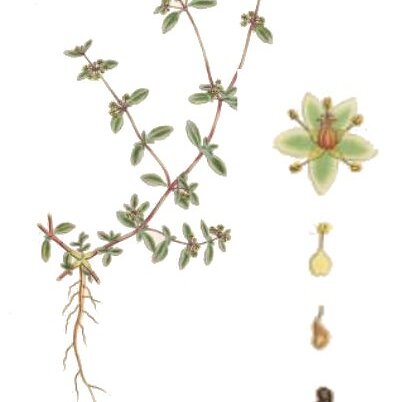Diffuse procumbent or creeping annual herbs, close-streaked with numerous short-linear whitish slightly prominent raphides. Leaves opposite, sessile or shortly petiolate, linear to oblanceolate-spathulate or elliptic, entire, sub-succulent. Stipules absent. Inflorescences axillary, umbelliform to laxly dichasial, sessile or pedunculate. Flowers hermaphrodite or unisexual, regular, pedicellate, small and inconspicuous. Sepals 5, free. Stamens 5–20, hypogynous, free. Carpels 3–6, or 10–15, superior, free, indehiscent, one-seeded, separating into achenes in fruit; pericarp thin, transparent, white-papillose; styles as many as the carpels.2 species, one African, the other extending from the Cape through tropical Africa and Asia to Malaysia.
Herbs, annual. Leaves opposite or appearing whorled. Inflorescences axillary, compound dichasia, appearing umbelliform. Flowers: sepals 5; stamens 5; carpels 5, free; ovaries 5, each 1-loculed; style and stigma 1 per carpel; stigma terminal. Fruits: group of thin-walled, lenticular achenes. Seed 1 per carpel.
Herbs, usually prostrate, procumbent or creeping, annual or perennial with annual shoots, many-stemmed, with numerous prominent linear whitish raphides especially on leaves.
Leaves mostly opposite, sessile or petiolate, succulent, without stipules, entire, with great variability in size and shape of the lamina.
Inflorescences terminal or axillary, umbelliform to loosely dichasial, sessile or pedunculate.
Carpels 5–15, superior, free, 1-ovulate, with a style on the inner edge of each carpel.
Fruit of separated achenes, usually muricate, covered with warts, black.
Flowers hermaphrodite or sometimes unisexual, small, pedicellate.
Perianth-segments 5, herbaceous, free.
Stamens 5–20, hypogynous, free.
Seeds swollen-reniform, black.


